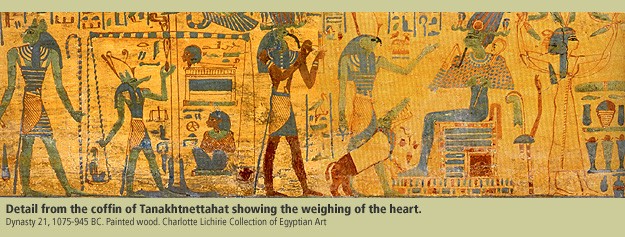In accordance with the Heliopolis creation myth, Atum was the first god to exist. The god, lonely, then decided to create the god Shu and the goddess Tefnut. The union of these two gods resulted in the birth of gods Geb and Nut. Finally, the children of Geb and Nut were Osiris, Set, Isis, and Nephthys.1
Osiris was the first ruler in Egyptian history, and he brought civilization to the land. Because of Osiris, agriculture, laws, religious institutions, and culture were given to the people of Egypt. During his reign was a time of prosperity for the ancient Egyptians. People were happy and so were the gods, except his brother Set. Set grew jealous, and resentful of Osiris’ success. Soon he began to plot his brother’s demise.2

Set threw a lavish and delicious banquet for his brother and his constituents. During the party, Set stood up and brought out a beautiful coffin, and announced a game. He told everyone at the feast that the person who could fit in the coffin could keep it. Unknown to the party attendees, Set had the coffin made to his brother’s exact measurements. One by one each of the guests attempted to fit into the coffin but were unsuccessful. Many tried to squeeze and shove themselves inside the carved box, but no one could fit comfortably inside the coffin. Finally, Osiris stood up to take his turn. As Osiris climbed into the box, Set seized the opportunity he had been plotting for. He shut and sealed the coffin with Osiris inside, and threw it into the Nile River. The river waters rushed Osiris’ living body out to sea, before finally resting in a tamarisk tree that was growing on the banks near Byblos in Phoenicia. Osiris, unable to break the seal on the coffin, struggled and fought for his life before dying in the very device intended to bury him.3
Isis, his wife and sister, was distraught by the events that transpired at Set’s feast. She decided that she would not rest until her husband’s body was found. Eventually, Isis succeeded in finding and retrieving Osiris’ body, and brought it back to Egypt. Once Isis and Osiris’ body were safely back in their homeland, the goddess then looked for a way to resurrect her beloved husband. As Isis searched for a solution, Set heard about his brother’s return. Set knew he had to act quickly, in order to make sure his plan for Osiris’ demise remained successful. Set found his brother’s body and cut it up into many pieces, and scattered them all over Egypt. Isis, upset about Set’s jealousy and interference, went on an expedition to find her husband, every piece of him. The goddess managed to retrieve all of Osiris’ body parts, except for one, to continue with her plan of revival. Isis was unable to find her husband’s penis, because it had been eaten by an oxyrhyncus fish. Regardless, Isis still managed to bring her husband back to life. During the resurrection, despite Osiris missing his genitalia, the god Horus was conceived during this time. Although Osiris was now alive and had co-created a son with his wife, he was still incomplete. Because of his missing body part he was unable to rule the land of the living. So Osiris was crowned the ruler of the Underworld.4

The word Osiris comes from the Egyptian word “Wsir.” This word can be translated to ‘powerful’ or ‘mighty’ in English.5 His job as ruler of the Underworld is to judge each Egyptian soul to determine their eligibility for the afterlife. In Egyptian art, the ruler of the Underworld is shown as being wrapped up from the chest downwards in mummy bandages. Another important feature of Osiris’ is his skin color, which is either green or black. He is typically these colors because green represents the color of rebirth and black symbolizes the color of fertility of the Nile Valley.6

Osiris judges the dead by weighing their hearts against a feather. If your heart is light, then you are allowed to pass into the Land of Two Fields. There are three requirements for entering the afterlife. First, your name had to be written down. Second, you had to have a preserved body and a tomb. Lastly, during your life you had to perform good deeds so your heart would be light enough to pass the weighing test when you met Anubis or Osiris in the underworld. The first two criteria were to insure that Ba and Ka, the two parts of ones soul, would be able to find its body each night to rest. The Ba was ones personality, and each day it would go and watch over ones family members in the land of the living. While ones Ka was a life force, it was unique to each person, and it would go each day to indulge in the Land of the Two Fields. If one lacked a written name on ones tomb or a preserved body then ones Ba and Ka would get lost and have no place to rest each night.7
- Don Nardo, Egyptian mythology (Detroit: Lucent Books an imprint of Gale, Cengage Learning, 2013), 48. ↵
- Don Nardo, Egyptian mythology (Detroit: Lucent Books an imprint of Gale, Cengage Learning, 2013), 49. ↵
- Don Nardo, Egyptian mythology (Detroit: Lucent Books an imprint of Gale, Cengage Learning, 2013), 50. ↵
- Don Nardo, Egyptian mythology (Detroit: Lucent Books an imprint of Gale, Cengage Learning, 2013), 52-53. ↵
- Salem Press Encyclopedia, January 2016, s.v. “Egyptian mythology,” by Shari P. Miller. ↵
- Robert A. Armour, Gods and Myths of Ancient Egypt (New York: American University in Cairo Press, 2001), 73, 141, 177. ↵
- Anthony Spalinger, “The Limitations of Formal Ancient Egyptian Religion,” Journal of Near Eastern Studies, no. 4 (1998): 241. ↵



94 comments
Francisco Cruzado
The curious correlation between missing genitalia and inability to govern amidst the living (i.e. in the real and visible world, as a clear image) amazes me. It leads me to believe in the prejudices of the time, but also in the plausible historical connections of the myth to some ruler castrado. Additionally, it intrigues me a lot why color black represented the fertility of the Nile river, would it be because of the mud, the dirt, or what else? As in any other mythological reading, it always fascinates its reader because of the assumptions imbedded in it, sometimes hard to explain or to connect with present times. Osiris is, indeed, an interesting figure, unfortunately oversimplified by popular culture. Very great summary of the character’s mythological biography!
Meadow Arriaga
This story explains how Osiris, became God of the Underworld. If it were not for Iris, his body would have remained unable for resurrection. She made the right decision knowing all of this was down out of spite. The character Set remains me of Satan in the Bible. I can notice similarities between the two. Egyptian history interests me because I believe we all originated from there.
Anthony Coronado
I loved how this story as being a story a fictional story about the pantheon of the Egyptian gods, showed the morals held during that time on how the people of faith should act, as well as the views and the existence of the afterlife held to the morals. As well as the thought os the existence of two kinds of human spiritual beings coexisting.
Sara Guerrero
I enjoyed this story and the twists that came to it for instance, how persistent Set was in that his brother Osiris wasn’t resurrected, yet Isis prevented it by finding Osiris’s body when he was in the tomb and spread throughout Egypt. When Osiris became ruler of the Underworld and the three requirements to enter the Land of Two Fields was something unexpected, but great story.
Olivia Tijerina
The message was quite unique when telling of the story of Osiris and his journey of his life, what came of his death, and what had happened afterwards. And it was quite a meticulous one when it came to Osiris’s demise because of his brother. A brother that wanted to end the success of Osiris but in reality his success never did end even if it lead to the precise detail of his body that led him qualified to do so.
D'Hannah Duran
Osiris and Isis have such a fascinating story when it comes to Egyptian Mythology. Jealousy can make people do terrible things which is what happens in this tale. If it hadn’t been for Set’s jealousy of Osiris things could have ended differently for both he and Isis. Though there would have been no tale of how the Underworld came to be.
Julia Edwin-Jeyakumar
What is set also passes through them, will Osiris let him through? This Egyptian story is quite fascinating and has a specific distinction when hearing their stories. Like the laws and physics of this world doesn’t matter, because they make their own sense of it. Its very interesting to learn about it. Also, how did isis know the resurrection would be successful? What kind of magic did she use? Ba and Ka remind me of the yin and yang in Chinese literature. This is an awesome story, great read!
Alexander Avina
I learned a lot about the practices of the early Egyptians. I didn’t know that much about the deities that they worshiped. This was a very informative article and a joy to read. I thought that it was very organized and executed brilliantly. I enjoyed how you focused on the differences in the gods, and how they were believed to influence the Egyptians everyday lives. I am glad that I read this article.
Elizabeth Maguire
Ancient Egyptian mythology is a very interesting topic, but one must wonder why no other parts of Osiris’ body were eaten by other creatures. The tale of Osiris and Isis is one of many fascinating aspects of Egyptian mythology. His story as a god incorporates many themes: judgment, hatred, love, and resurrection of life. I found this article very intriguing with some great story telling.
Nicholas Robitille
Ancient Egyptian mythology is very interesting, but one must wonder why no other parts of Osiris’ body were eaten. Another thing one must wonder is the origin of stories like these. Many stories from ancient mythology were meant to have a moral or teach a lesson, but I truly must wonder what lesson this is supposed to teach. It is very interesting, however, that this is how Osiris became the ruler of Egyptian afterlife, as I did not realize that this was how it happened.